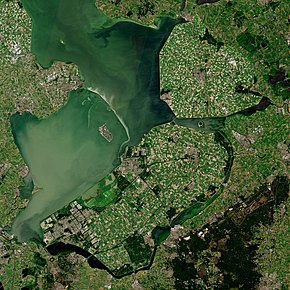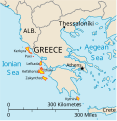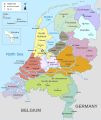Portal:Islands
The Islands Portal
This is a list of the lists of islands in the world grouped by country, by continent, by body of water, and by other classifications. For rank-order lists, see the other lists of islands below. (Full article...)
Selected article –

An artificial island or man-made island is an island that has been constructed by humans rather than formed through natural processes. Other definitions may suggest that artificial islands are lands with the characteristics of human intervention in their format process, while others argue that artificial islands are created by expanding existing islets, constructing on existing reefs, or amalgamating several islets together. Although constructing artificial islands is not a modern phenomenon, there is no definite legal definition of it. Artificial islands may vary in size from small islets reclaimed solely to support a single pillar of a building or structure to those that support entire communities and cities. Archaeologists argue that such islands were created as far back as the Neolithic era. Early artificial islands included floating structures in still waters or wooden or megalithic structures erected in shallow waters (e.g. crannógs and Nan Madol discussed below).
In modern times, artificial islands are usually formed by land reclamation, but some are formed by flooding of valleys resulting in the tops of former knolls getting isolated by water (e.g., Barro Colorado Island). There are several reasons for the construction of these islands, which include residential, industrial, commercial, structural (for bridge pylons) or strategic purposes. One of the world's largest artificial islands, René-Levasseur Island, was formed by the flooding of two adjacent reservoirs. Technological advancements have made it feasible to build artificial islands in waters as deep as 75 meters. The size of the waves and the structural integrity of the island play a crucial role in determining the maximum depth. (Full article...)
Selected cuisines, dishes and foods –
Marshallese cuisine comprises the fare, foods, beverages and foodways of the Marshall Islands, including its food-related customs and traditions. Common indigenous and traditional foods include breadfruit, coconut, bananas, papaya, seafood, pandanus and bwiro. Additional imported foods, such as rice and flour, are also a part of people's diets and contribute to the cuisine as well. The practice of food preservation is a part of the history of the islands, and continues to occur today. (Full article...)
Related articles
- List articles
- List of islands
- List of islands by area
- List of islands by highest point
- List of islands by name
- List of islands by population
- List of islands by population density
- List of archipelagos
- List of archipelagos by number of islands
- List of artificial islands
- List of divided islands
- List of fictional islands
- List of island countries
- List of islands in lakes
- List of islands named after people
- List of islands of the European Union
- List of private islands
Selected image –
Did you know –

- ... that Curtis Island has risen by 18 metres (59 ft) during the last 200 years?
- ... that an all-male boating event on Tinsley Island was called the "Bohemian Grove of yachting"?
- ... that the practice of whaling in the Faroe Islands dates back to the early days of Norse settlement during the Viking Era?
- ... that a Japanese island has rapidly fluctuated in size?
- ... that the Germanic seeress Waluburg is only known from a pot shard found on the island Elephantine in southern Egypt?
- ... that Oh My God, Charlie Darwin was recorded by the Low Anthem in ten days in a Block Island basement?
General images –
Related portals
WikiProjects
Topics
Categories
Associated Wikimedia
The following Wikimedia Foundation sister projects provide more on this subject:
-
Commons
Free media repository -
Wikibooks
Free textbooks and manuals -
Wikidata
Free knowledge base -
Wikinews
Free-content news -
Wikiquote
Collection of quotations -
Wikisource
Free-content library -
Wikiversity
Free learning tools -
Wikivoyage
Free travel guide -
Wiktionary
Dictionary and thesaurus
Things to do
 |
Here are some tasks awaiting attention:
|
Web resources
- Listing of islands from the United Nations Island Directory




























![Image 25The Shamanka Шаманка [ru], a holy rock in Shamanism and one of the 9 most holy places in Asia, on the westcoast of Olkhon (from List of islands of Russia)](https://upload.wikimedia.org/wikipedia/commons/thumb/2/27/Shaman_Kamen.jpg/120px-Shaman_Kamen.jpg)








































































